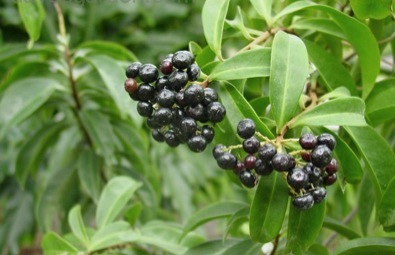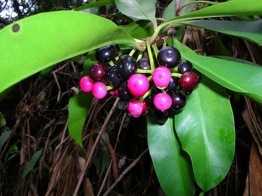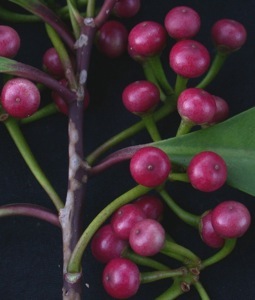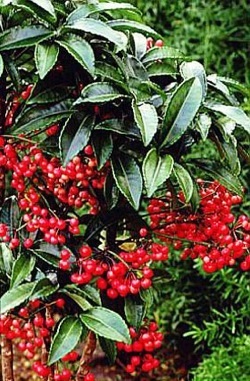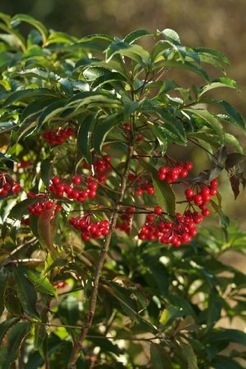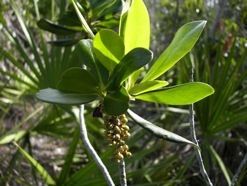Ardisias: Berries on the cusp of edible
The Ardisias are a confusing family in Florida.
There is the native Marlberry (Ardisia escallonioides) that has edible black fruit that ranges from bad to almost good. There is the invasive Asian, Ardisia elliptica, whose berries are edible but insipid. Another Oriental upstart has escaped and is occasionally found, the Ardisia solanaea. Its berries and young leafy shoots are edible. There is also the escaped Ardisea crispa, with edible shoots. Lastly there is the Ardisia crenata, which is not listed as toxic but some think it is potentially toxic. It is suspected of killing cattle in 2001 and 2007 in Florida. I ate the flesh off one seed and had no problem. It kind of tasted like a raw pea, but had the texture of a cooked bean. Neither appealing or offensive.
Marlberries, as you might of assumed by now, are not high on the foraging list. They should be placed on the cusp between forage food and survival food. But that is a matter of opinion, or how hungry you are. Some think the pulp of the marlberries taste close to blackberries, grapes and raisins. Others say they are unappealing and acidic. You eat the pulp only, not the seed.
Native marlberries (A. escallonioides) often occur naturally with Sabal Palmettos, the Cabbage Palms. Marlberries are found mid-state south with more representation along the coasts than inland. You’ll see it in the interior of dense, shady hardwood hammocks, usually under a canopy live oaks and cabbage palms. It is in the common shrub layer with Wild Coffee (Psychotria nervosa and Psychotria sulzneri) and American Beautyberry (Callicarpa americana.) See separate entires for those. It is very common Highlands Hammock State Park, and in hardwood hammocks in the Everglades.
The Shoebutton Ardisia, Ardisia Elliptica, is on the state’s hit list. It is very invasive and the fruit edible as well, but not up to the already low standard set by the native Marlberry. Nibbling on the A. elliptica and destroying the seed is being a good citizen.
Now, how do you tell the first two ardisia apart? Blossoms and leaves. The blossoms on the Marlberry (A. escallonioides) tend to be in non-drooping white clusters (or pink) with purple lines and spots. The flowers of the Shoebutton (A. elliptica) are purple to violet or pink white and are found in small, hanging clusters. The Shoebutton also tends to have narrow long leaves and the Marlberry wide long leaves, up to two inches wide.
A third Ardisia, the solanacea, is also found in South Florida and has edible berries as well. The tender, leafy shoots, parboiled, washed, drained and seasoned are a favorite salad ingredient for the Thai in southern Yunnan, China. The A. solanaceais a shrubs or tree to 20 feet tall, smooth, leaves elliptic or oblanceolate,
papery, with conspicuous spotted. Fruit purplish red or blackish.
A. crispa, aka spiceberry, also has edible young shoots. The berries range from purple red to black. Some internet sites say the plant is toxic but ethnobotanical studies show it was and is eaten in China. It’s a shrubs to about five feet, stems brown, scaly when young. leaf lance shaped, wavy, dotted. Fruit reddish, globular. They last through the winter and spring.
On the “it’s anybody’s guess list” is the A. crenata. The state of Florida flatly says: “It is suspected that the berries and/or foliage are poisonous to livestock, pets, and humans.” As mentioned, I did eat the pulp off one seed and suffered no ill effects that I am aware of (for the researchers, adult male, 167 lbs. age 58.) Once it puts on berries they can persist for a year or two.
If that is not enough there is a relative of the Ardisias also in the woods, the Rapanea punctata. It looks similar but the berries are on the stems, like the Beautyberry (Callicarpa Americana.) The edibility of those berries is not reported but the Indians used the leaves to extend their tobacco.
Ardisia (ar-DIZ-ee-uh) is from the Greek word ardis, which means pointed, and refers to the plant’s anthers. Escallonioides (ess-kal-lon-ee-OY-deez) is for for Escallon, 18th century Spanish plant explorer Antonio Escallon who also has a genus named after him, Escallonia. Elliptica (ee-LIP-tih-kuh) means elliptical, or about twice as long as wide. Solanacea (so-lan-uh-SEE-us ) means resembling the Solanace family. Crispa (KRISP-un) means wavy or curled, as in the edge of the leaf. Crenata (kre-NAH-tuh) means scalloped, as in the edges of the leaves. Rapanea (ra-PAN- ee-uh) is from the French Guianian name for this shrub. Punctata (punk-TAH-tah) spotted, dotted with glands. Marl as in Marlberry is a shortened form of “marvel” because it can grow in poor condition.
Lastly, don’t confuse a red-berried Ardisia with any Psychotria, which have very prominent veins but smooth edges to the leaves.
Green Deane’s “Itemized” Plant Profile
IDENTIFICATION: Marlberry only: Shrub or small tree to 25 feet, whitish scaly bark, and purplish branch tips. Leave alternate, oblanceolate to elliptical, two to seven inches, leathery. Flowers small, white or pink with purple lines and dots, bell shaped, five lobed, fragrant, smell spicy, in showy terminal clusters. Fruit round, dark purple, glossy, quarter inch wide, mealy, juicy, sweet, one seed, in dense clusters.
TIME OF YEAR: Flowers in fall, fruits in spring
ENVIRONMENT: Woodlands and hammocks
METHOD OF PREPARATION: Pulp of the fruit edible raw. Leaves can be mixed with tobacco as an extender.

